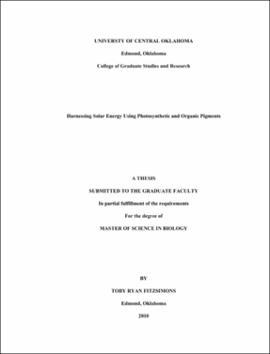| dc.description.abstract | "Fossil fuels are a finite energy resource that must be supplemented or replaced by more stable forms of electrical energy. Solar technology research strives to supplement and provide eventual replacement for fossil fuel technology. This experiment focused on the use of natural pigments as photo-sensitizers in the current generation of solar cells called dye sensitized solar cells (DSSCs). Pigments from purified chlorophyll a, chlorophyll b, chlorophyll a/b, crude spinach (Spinacia oleracea) extract, phycocyanin, and chlorophyllin were used to construct DSSCs and evaluated, along with a control containing no pigment, for solar energy conversion. The anode of the solar cells consisted of titanium dioxide (TiO2) plates soaked in pigment solutions for twenty-four hours. The plates were assembled, along with an electrolyte sandwiched between cells, and a platinum-coated counter plate that functioned as the cathode. A gasket seal was placed between the plates and held together with rubber bands. The DSSCs were each tested for a maximum power (Pmax) point and a resistor was selected that corresponded to the resistance at that point. The cells were randomly placed into a power block assembly located in an environmental chamber with lighting that provided an average of 27,590 lumens at the surface of DSSCs. With appropriate resistors in place, the cells were subjected to twelve-hour days and twelve-hour nights for ten days, and measurements were recorded every ten minutes. Data were collected to obtain values for voltage in millivolts (mV), current in microamps (æA), and power in microwatts (æW), as well as beginning and ending efficiencies in converting light to usable energy. Voltages were substantially higher during the day than at night for all pigments, except for the control, indicating that the pigments functioned as DSSCs. Hence, only daytime values were used for data analysis. Voltage during the ten-day experiment ranged from 3.99 to 274 mV; current ranged from 0.0180 to 41.9 æA, and power ranged from 0.00 to 11.3 æW. Chlorophyllin had the highest peak and least voltage (274 and 161 mV), highest peak and least current (41.9 and 21.8 æA), and highest peak and least power (11.3 and 4.84 æW). The ranking of the pigments for peak voltage was: Chlorophyllin = Crude Extract ; Chlorophyll a = Chlorophyll a/b ; Phycocyanin = Chlorophyll b > Control. The ranking for least voltage was: Chlorophyllin > Phycocyanin ; Chlorophyll a/b ; Crude Extract ; Chlorophyll b ; Chlorophyll a ; Control. Ranking for peak and least values were similar for current and power. Solar energy conversion (efficiency in converting light energy to usable energy in watts per square meter) for all treatments ranged from 0.000595 to 0.0217% at the beginning of the experiment, and was highest in cells constructed with chlorophyllin. Based on rankings from peak and ending voltage values, as well as other measurements, it was concluded that DSSCs constructed with chlorophyllin performed the best and lasted the longest as photo-sensitizers, compared to other pigments used in this investigation. The DSSCs constructed with crude extract performed almost as well as those constructed with chlorophyllin at the beginning of the experiment, but degradation of this naturally-made pigment may have prevented these cells from sustaining solar energy conversion for more than a few days. Other pigments demonstrated conversion values higher than those of control DSSCs which contained no pigments. The results from this project provide evidence that DSSCs can produce useable energy. More research is needed to enhance and prolong the efficiency of DSSCs in solar energy conversion."--Abstract." | |
